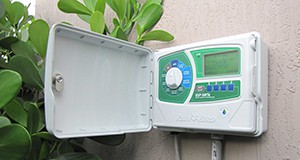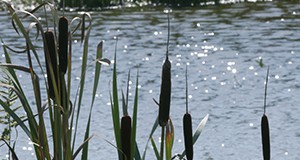![]()
A soil moisture sensor (SMS) is a device that detects how much moisture is in the soil and prevents an irrigation system from running when it is not needed. This 4-page fact sheet written by Paul Monaghan, Ondine Wells, Michael Dukes, Maria Morera, and Laura Warner and published by the Department of Agricultural Education and Communications explains how the technology functions as well as how to install, program, operate, and maintain an SMS for a money- and water-wise sustainable home landscape that’s lush and beautiful.
http://edis.ifas.ufl.edu/wc238
Tag: Ondine Wells
Frequently Asked Questions about Evapotranspiration (ET) Irrigation Controllers
Evapotranspiration is the amount of water that is released into the atmosphere through evaporation and plant transpiration. An evapotranspiration irrigation controller is a device that uses data about the landscape, the type of irrigation system, and local weather conditions to determine when and how much to irrigate. This 5-page fact sheet written by Paul Monaghan, Ondine Wells, Michael Dukes, Maria Morera, and Laura Warner and published by the Department of Agricultural Education and Communications explains how the technology functions as well as how to install, program, operate, and maintain an ET controller for a money- and water-wise sustainable home landscape that’s lush and beautiful.
http://edis.ifas.ufl.edu/wc237
Strategies to Encourage Adoption of Stormwater Pond Best Management Practices (BMPs) by Homeowners
Man-made ponds can be a useful way to collect, store, and treat stormwater runoff in residential areas. However, these ponds can become polluted when runoff contains fertilizers, pesticides, and pet waste from the neighborhood. This 8-page fact sheet outlines several best management practices (BMPs) for reducing stormwater pond pollution. Based on a survey of residents who live near stormwater ponds, the authors recommend strategies Extension educators can use to encourage residents to adopt these BMPs. Written by Emily Ott, Paul Monaghan, Ondine Wells, Gail Hansen, Laura Warner, and Michelle Atkinson, and published by the UF Department of Agricultural Education and Communication, July 2015.
http://edis.ifas.ufl.edu/wc214
The Florida Natural Resources Leadership Institute
 We are all dependent on Florida’s natural resources for jobs, health, and our quality of life. Decisions about the management and conservation of the State’s environment involve complex sets of issues and stakeholders. Expensive and time-consuming disputes often emerge over topics such as endangered species, land use, coastal and marine resources, and water quality and quantity. Effective leadership in managing such issues requires a specialized set of skills, tools, and strategies to build trust and promote innovation and collaboration among competing interests. To meet these needs, the Florida Natural Resources Leadership Institute (NRLI) was founded in 1998 to bring together professionals and stakeholders from diverse natural resource sectors to develop the skills required to engage the public and one another in collaborative decision-making. This 4-page fact sheet was written by Paul Monaghan, Emily Ott, Carol Lippincott, Ondine Wells, Jessica Ireland, Jon Dain, Bruce Delaney, and Roy Carriker, and published by the UF Department of Food and Resource Economics, December 2014.
We are all dependent on Florida’s natural resources for jobs, health, and our quality of life. Decisions about the management and conservation of the State’s environment involve complex sets of issues and stakeholders. Expensive and time-consuming disputes often emerge over topics such as endangered species, land use, coastal and marine resources, and water quality and quantity. Effective leadership in managing such issues requires a specialized set of skills, tools, and strategies to build trust and promote innovation and collaboration among competing interests. To meet these needs, the Florida Natural Resources Leadership Institute (NRLI) was founded in 1998 to bring together professionals and stakeholders from diverse natural resource sectors to develop the skills required to engage the public and one another in collaborative decision-making. This 4-page fact sheet was written by Paul Monaghan, Emily Ott, Carol Lippincott, Ondine Wells, Jessica Ireland, Jon Dain, Bruce Delaney, and Roy Carriker, and published by the UF Department of Food and Resource Economics, December 2014.
http://edis.ifas.ufl.edu/fe667

